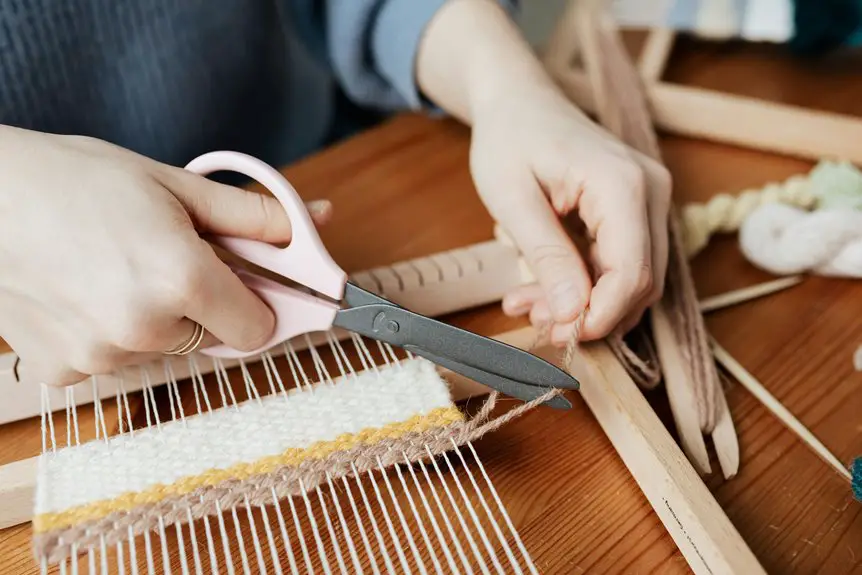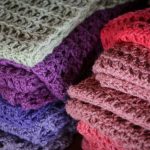You can use abaca fiber in amazing ways you might not expect. It’s perfect for strong, eco-friendly ropes and biodegradable packaging. You’ll find it in handmade paper, durable fashion textiles, and comfy upholstery. It also shines in baskets, sustainable footwear, and natural home décor. Whether protecting crops or boosting vehicle parts, abaca combines strength with sustainability. Keep exploring, and you’ll uncover even more remarkable, earth-friendly uses for this versatile fiber.
Table of Contents
Key Takeaways
- Abaca fiber is used in sustainable fashion for durable, breathable clothing, eco-friendly footwear, and stylish accessories.
- It creates strong, biodegradable packaging and disposable bags that reduce plastic waste and support environmental health.
- Handmade paper and bookbinding benefit from abaca’s exceptional strength and natural texture for long-lasting, eco-friendly products.
- In industry, abaca reinforces composites, serves in automotive lightweight parts, and strengthens marine vessels with moisture resistance.
- Home décor applications include durable upholstery, eco-friendly wall coverings, natural fiber rugs, and decorative baskets with rustic charm.
Traditional Rope and Cordage
Rope has been an essential tool for centuries, and abaca fiber plays a key role in its traditional production.
When you choose abaca rope, you’re getting a material known for its incredible strength and durability. Unlike synthetic fibers, abaca resists saltwater damage, making it perfect for maritime use. You’ll find it in fishing nets, ship ropes, and even in agriculture for tying plants.
Its natural fibers provide excellent grip and flexibility, so you won’t struggle with slipping or breaking. Plus, abaca rope is biodegradable, so when you’re done with it, it won’t harm the environment.
If you need reliable cordage for outdoor or heavy-duty tasks, abaca fiber rope offers a time-tested, sustainable solution you can count on.
Eco-Friendly Packaging Material
You’ll appreciate how abaca fiber makes packaging both durable and eco-friendly.
Its natural strength guarantees your products stay protected, while its biodegradable nature helps reduce waste.
Choosing abaca means supporting sustainability without sacrificing quality.
Biodegradable Packaging Benefits
Although many packaging materials harm the environment, abaca fiber offers an eco-friendly alternative that breaks down naturally without leaving toxic residues. When you choose abaca-based packaging, you reduce landfill waste and lower pollution. Plus, it supports a circular economy by returning nutrients to the soil. Using biodegradable packaging also appeals to eco-conscious consumers, enhancing your brand’s reputation.
Here’s a quick look at the benefits:
| Benefit | Why It Matters |
|---|---|
| Reduces Waste | Decomposes quickly in natural settings |
| Non-Toxic | Safe for soil and water systems |
| Consumer Appeal | Attracts environmentally aware buyers |
| Supports Sustainability | Helps close the resource loop |
Durability and Sustainability
Abaca fiber boasts impressive durability that makes it an excellent choice for eco-friendly packaging.
When you choose abaca, you’re opting for a material that can withstand wear and tear while being gentle on the planet. Its natural strength means your packages stay secure without relying on plastics or synthetic fibers.
Plus, abaca decomposes quickly, reducing landfill waste.
Imagine packaging that offers:
- Resistance to moisture and tearing
- Lightweight yet strong protection
- Biodegradable fibers that enrich soil after use
- Reduced carbon footprint compared to plastic alternatives
Handmade Paper Production
When you use abaca fiber for handmade paper, you get a product that’s both strong and long-lasting.
You’ll also appreciate how this eco-friendly process reduces waste and supports sustainable crafting.
Let’s explore how abaca transforms simple paper into something durable and green.
Durable Paper Qualities
If you want paper that lasts, handmade sheets made from abaca fiber are an excellent choice. This fiber’s natural strength gives the paper exceptional durability, making it resistant to tearing and wear.
When you handle abaca paper, you’ll notice its coarse texture and toughness, perfect for documents and artwork needing longevity. Its resistance to moisture and insects means your creations stay intact over time.
Imagine:
- Thick, fibrous sheets that resist ripping
- A natural sheen that doesn’t fade
- Paper that holds ink without bleeding
- Textured surfaces ideal for detailed prints
Using abaca fiber, you get a paper that’s not only strong but also maintains its quality through years of use. It’s a smart option for anyone valuing durability and craftsmanship.
Eco-Friendly Crafting Benefits
Because handmade paper production relies on natural fibers and traditional methods, it offers a sustainable alternative to mass-produced paper.
When you work with abaca fiber, you’re using a renewable resource that biodegrades easily, minimizing environmental impact. Its strength and flexibility make it ideal for crafting durable, eco-friendly paper.
By choosing abaca-based handmade paper, you support local artisans who preserve cultural techniques and reduce reliance on chemical processing. This process uses less water and energy, so you’re cutting down on pollution too.
Plus, the unique texture and appearance of abaca paper add a natural, artistic touch to your projects. Embracing abaca fiber in handmade paper production lets you create beautiful crafts while protecting the planet.
Sustainable Fashion Textiles
Although sustainable fashion is gaining momentum, you mightn’t realize how versatile abaca fiber can be in this industry. This natural fiber offers durability and breathability, making it perfect for eco-conscious designers.
Discover abaca fiber’s durability and breathability, ideal for sustainable, eco-conscious fashion creations.
When you choose abaca, you’re supporting renewable resources and reducing reliance on synthetic fabrics.
Imagine wearing clothes made from abaca fiber that feature:
- Lightweight, breathable summer dresses
- Stylish, biodegradable handbags
- Durable, eco-friendly footwear
- Soft yet strong scarves and wraps
These items not only look great but also minimize environmental impact.
Interior Upholstery Fabrics
When you choose upholstery fabrics, you want something that’s both durable and comfortable.
Abaca fiber offers a strong, eco-friendly option that stands up to daily wear.
Let’s explore how it fits perfectly into sustainable interior design.
Durability and Comfort
If you’re looking for interior upholstery fabrics that combine strength with comfort, abaca fiber stands out as an excellent choice. This natural fiber offers remarkable durability, resisting wear and tear even in high-traffic areas.
At the same time, it provides a soft, breathable texture that makes your furniture inviting and cozy. When you choose abaca upholstery, you get:
- Long-lasting fabric that holds its shape
- A smooth yet slightly textured feel under your fingertips
- Resistance to stretching and sagging over time
- Natural breathability that keeps seating comfortable and fresh
With abaca fiber, you don’t have to sacrifice comfort for toughness. It’s ideal for sofas, chairs, and cushions that see daily use but still need to look good and feel great.
Eco-Friendly Fabric Choices
Choosing abaca fiber for your upholstery not only gives you durability and comfort but also supports eco-friendly fabric options.
When you opt for abaca, you’re choosing a natural, biodegradable material that reduces reliance on synthetic fabrics. This fiber requires minimal chemical processing and uses less water, making it a sustainable choice.
You’ll find abaca fabrics are breathable, resistant to wear, and add a unique texture to your furniture. Plus, abaca’s fast growth cycle means it replenishes quickly, helping you maintain an eco-conscious home without sacrificing style.
By selecting abaca for your interior upholstery, you actively reduce your environmental footprint while enjoying a beautiful, long-lasting fabric that blends nature with practicality.
It’s a smart, green choice you can feel good about.
Decorative Wall Coverings
Although decorative wall coverings might seem like a small detail, they can transform any space with the unique texture and natural appeal of abaca fiber.
When you choose abaca for your walls, you bring in a warm, organic vibe that’s both stylish and sustainable. Its natural fibers create a subtle, woven pattern that adds depth without overwhelming your decor.
You’ll love how it:
- Softens the room with earthy tones
- Reflects light gently, creating a cozy glow
- Adds a tactile element that invites touch
- Complements both modern and rustic interiors
Using abaca fiber for wall coverings gives your space an eco-friendly upgrade while making it feel inviting and unique.
Abaca fiber wall coverings offer an eco-friendly touch that transforms your space into a warm, inviting haven.
It’s a simple change that makes a big impact.
Reinforcement in Composite Materials
When you incorporate abaca fiber into composite materials, you boost their strength and durability without adding much weight. This natural fiber’s high tensile strength makes it an excellent reinforcement agent, improving impact resistance and flexibility in composites.
You’ll find abaca fiber enhances mechanical properties in automotive parts, construction panels, and sports equipment. Its biodegradability also offers an eco-friendly alternative to synthetic fibers, reducing environmental impact.
Plus, abaca fibers bond well with various resins, ensuring a strong, cohesive matrix. By choosing abaca fiber, you get lightweight composites that don’t compromise on performance.
Natural Fiber Mats and Rugs
Since abaca fibers are naturally durable and resistant to moisture, they make excellent materials for mats and rugs.
When you choose abaca mats, you get products that withstand heavy foot traffic and resist mold and mildew, perfect for both indoor and outdoor use.
You’ll love how these mats add a rustic, earthy charm to your space without sacrificing strength.
Imagine walking barefoot on:
- A soft, textured surface that feels natural underfoot
- A vibrant woven pattern that brightens your entryway
- A sturdy mat that dries quickly after rain
- An eco-friendly rug that lasts for years without fraying
Using abaca fiber mats and rugs means you’re investing in longevity, style, and sustainability all at once.
Biodegradable Disposable Bags
You can find a variety of biodegradable disposable bags made from abaca fiber that break down quickly and reduce environmental impact.
When you choose these bags, you’re opting for a sustainable alternative to plastic, which often lingers for centuries. Abaca fiber’s natural strength lets these bags hold heavy items without tearing, making them practical for everyday use.
Plus, since abaca decomposes naturally, your waste won’t contribute to landfill buildup or ocean pollution. You don’t have to sacrifice durability for eco-friendliness with these bags—they’re sturdy, lightweight, and compostable.
Using biodegradable abaca bags supports both the environment and local farmers who cultivate the fiber.
Artistic Weaving and Craftwork
Although abaca fiber is prized for its strength and eco-friendly qualities, it also shines in artistic weaving and craftwork.
Abaca fiber’s strength and eco-friendliness make it perfect for stunning artistic weaving and craftwork.
You’ll be amazed at how its natural texture brings warmth and uniqueness to handmade items. When you work with abaca, you’ll notice how flexible yet durable it feels, making it perfect for creative projects.
Imagine crafting:
- Intricately patterned baskets with a rustic charm
- Elegant mats that add a natural touch to any room
- Decorative wall hangings showcasing vibrant, earthy tones
- Handwoven bags that combine style with sustainability
High-Quality Tea Bags
Abaca fiber’s natural strength and biodegradability make it an excellent choice for high-quality tea bags. When you use tea bags made from abaca, you get a product that resists tearing or breaking during steeping, so your tea brews without any mess.
Plus, since abaca is eco-friendly, you don’t have to worry about adding plastic waste to the environment. Its porous texture lets water flow through easily, ensuring your tea’s flavor infuses fully and evenly.
Many premium tea brands choose abaca because it holds up well under hot water without releasing unwanted chemicals, unlike some synthetic materials. By opting for abaca fiber tea bags, you’re supporting sustainable practices and enjoying a pure, rich tea experience every time.
Carpentry and Furniture Accents
When you choose abaca for carpentry, you get durable wood inlays that add strength and style.
You can also opt for eco-friendly chair upholstery that’s both comfortable and sustainable.
Plus, textured cabinet detailing with abaca brings a unique, natural touch to your furniture.
Durable Abaca Wood Inlays
If you’re looking to add a unique touch to your carpentry projects, durable abaca wood inlays offer both strength and aesthetic appeal.
You can enhance furniture pieces by incorporating these natural accents that resist wear and add a distinct texture. Abaca wood’s fine grain and rich color make it perfect for detailed inlay work, giving your creations an organic yet refined look.
Consider using abaca wood inlays to:
- Highlight cabinet doors with intricate patterns
- Accentuate table edges for a rustic charm
- Create custom designs on drawer fronts
- Add decorative borders to wooden frames
Eco-Friendly Chair Upholstery
Adding eco-friendly upholstery to your chairs can elevate both their comfort and sustainability.
Abaca fiber offers a natural, breathable fabric that’s durable and resistant to wear, making it perfect for chair upholstery. When you choose abaca, you’re opting for a renewable resource that’s biodegradable and free from harmful chemicals.
Its unique texture adds a rustic charm while providing a soft yet sturdy seating surface. You can easily clean abaca upholstery with mild soap and water, keeping maintenance simple.
Plus, abaca’s moisture-wicking properties help prevent mildew and odors, enhancing the longevity of your furniture.
Textured Cabinet Detailing
Textured cabinet detailing transforms ordinary furniture into eye-catching accents that bring character and depth to any space.
By integrating abaca fiber into your cabinet surfaces, you add a natural, tactile element that’s both stylish and sustainable. You’ll appreciate how abaca’s unique texture enhances the visual appeal without overwhelming the design.
Imagine running your fingers over:
- Subtle woven patterns that catch the light differently throughout the day
- Raised fiber strips creating a rhythmic, handcrafted feel
- Natural color variations adding warmth and organic charm
- Durable finishes that protect while showcasing the fiber’s beauty
Using abaca fiber in cabinet detailing not only gives your furniture a fresh, artisanal look but also supports eco-conscious choices.
It’s a simple way to elevate your carpentry projects with nature’s touch.
Acoustic Panels for Soundproofing
When you want to reduce noise and improve sound quality in a space, abaca fiber makes an excellent material for acoustic panels. Its natural fibers absorb sound waves effectively, cutting down echo and background noise.
You’ll find abaca panels lightweight yet durable, making installation easier and long-lasting. Plus, they offer a unique, natural texture that enhances your room’s aesthetic without synthetic materials.
These panels work well in offices, studios, or home theaters, helping you create a quieter, more comfortable environment. Since abaca is breathable, it also helps regulate humidity, preventing moisture buildup behind panels.
Environmentally Friendly Bookbinding
You can create durable, eco-friendly book covers using abaca fiber that also bring a unique natural texture to your projects.
Using sustainable adhesives keeps your bookbinding process green and safe for the environment.
Let’s explore how these materials make your books both beautiful and earth-conscious.
Durable Eco-Friendly Covers
Abaca fiber offers a strong, sustainable alternative for creating durable eco-friendly covers in bookbinding.
When you choose abaca for your book covers, you’re picking a material that resists wear and tear, ensuring your books last longer while reducing environmental impact. Its natural strength means your covers can handle daily use without fraying or weakening.
Plus, abaca’s biodegradability keeps your eco-conscious projects truly green.
Imagine crafting covers that feature:
- A robust yet lightweight texture
- Resistance to moisture and mildew
- Flexibility for easy handling
- A naturally renewable source
Natural Texture Appeal
The natural texture of abaca fiber brings a unique, tactile charm to environmentally friendly bookbinding. When you hold a book bound with abaca, you immediately notice the subtle roughness and organic feel that synthetic materials simply can’t replicate.
This texture not only enhances the sensory experience but also adds visual depth, making each book feel handcrafted and special. You’ll appreciate how abaca’s fibrous surface interacts with light, giving covers a natural sheen that changes with every angle.
Plus, its strength and flexibility mean the material holds up well without needing chemical treatments. By choosing abaca fiber, you’re embracing a sustainable option that elevates both the look and feel of your books, connecting you to nature with every page you turn.
Sustainable Adhesive Alternatives
While the natural texture of abaca fiber enhances your book’s cover, the choice of adhesive plays a key role in keeping the binding eco-friendly.
You want adhesives that complement abaca’s sustainability without compromising durability. Fortunately, several natural and non-toxic options exist. You can try:
- Rice starch paste, which offers strong hold and is biodegradable
- Wheat gluten glue, known for flexibility and water resistance
- Gum arabic, a natural resin that dries clear and is non-toxic
- Casein glue, derived from milk protein, providing excellent adhesion
Using these sustainable adhesives guarantees your books stay beautifully bound while minimizing environmental impact.
Agricultural Crop Protection
Although you mightn’t immediately connect natural fibers with farming, abaca fiber plays an essential role in agricultural crop protection.
You can use abaca fiber to create durable, biodegradable mats and nets that shield crops from pests and harsh weather without harming the environment. These natural barriers reduce reliance on chemical pesticides, promoting healthier soil and plants.
When you use abaca fiber products, you also support sustainable farming practices since the fiber breaks down naturally, enriching the soil after use. Plus, abaca’s strength guarantees that protective coverings last through tough conditions, offering reliable defense for your crops.
Lightweight Automotive Components
Automakers rely on abaca fiber to create lightweight components that boost vehicle efficiency and reduce emissions. When you think about car parts, imagine abaca fiber reinforcing materials that cut down weight without sacrificing strength. This natural fiber helps you get better fuel economy and lowers your carbon footprint.
You’ll find abaca fiber in:
- Door panels that feel sturdy yet light
- Dashboard components designed for durability
- Seatbacks that support comfort and safety
- Interior trims that combine style with function
Using abaca fiber means you’re choosing sustainable, renewable resources in automotive design. It’s a smart way to enhance performance and contribute to greener driving.
Next time you see a car, remember how abaca fiber plays a key role under the surface.
Marine Industry Applications
Abaca fiber strengthens marine vessels by adding lightweight durability that resists moisture and wear. When you use abaca in boat building, you get a natural material that withstands harsh saltwater environments better than many synthetic fibers.
Its resistance to water absorption helps prevent rot and degradation, making your vessels last longer with less maintenance. You’ll find abaca reinforcing hulls, decks, and interiors, offering a sustainable alternative to fiberglass and other plastics.
Plus, its flexibility and strength improve impact resistance, so your boat can handle rough waves more effectively. Choosing abaca also means you’re supporting eco-friendly practices since it’s biodegradable and renewable.
Its flexibility and strength boost impact resistance, making boats tougher and supporting eco-friendly, renewable materials.
Incorporating abaca fiber into marine applications not only boosts performance but also aligns with greener maritime innovations you can feel good about.
Handmade Baskets and Containers
You’ll find that handmade baskets and containers crafted from abaca fiber combine strength and flexibility in a way few materials can match.
When you choose abaca, you’re getting durability that withstands heavy loads without losing shape. The natural texture also adds a rustic charm, making each piece unique and visually appealing.
Imagine holding:
- A wide, woven basket perfect for fresh produce
- A sturdy container to organize household essentials
- A decorative planter holder that breathes
- A lightweight picnic basket that travels easily
These baskets don’t just serve a purpose; they bring natural beauty into your space.
Eco-Conscious Footwear Materials
When seeking footwear that’s kind to the planet, materials like abaca fiber offer a sustainable alternative without sacrificing quality or comfort.
You’ll find abaca fiber in eco-conscious shoes because it’s strong, lightweight, and naturally breathable. This fiber provides durability for soles and uppers while keeping your feet cool and dry.
Plus, it biodegrades easily, reducing landfill waste when your shoes wear out. Manufacturers often weave abaca with other natural fibers to create flexible, stylish footwear that resists water and wear.
By choosing shoes made with abaca fiber, you support sustainable agriculture and reduce reliance on synthetic materials that pollute.
Insulation Material for Buildings
Since energy efficiency is a priority in modern construction, using natural insulation materials like abaca fiber can make a big difference.
You’ll find abaca fiber offers excellent thermal resistance, keeping your building cooler in summer and warmer in winter. It’s lightweight yet durable, easy to handle during installation, and environmentally friendly, reducing your carbon footprint.
Imagine insulating your walls with abaca fiber, which:
- Traps air effectively to minimize heat transfer
- Absorbs sound for a quieter indoor space
- Resists moisture, preventing mold and mildew
- Breaks down naturally at the end of its life cycle
Sustainable Home Décor Accessories
Although sustainable choices often require extra effort, incorporating abaca fiber into your home décor makes it easy to blend style with eco-friendliness.
You can find abaca fiber woven into beautiful baskets, lampshades, and wall hangings that add natural texture and warmth to any room. Its durability means these accessories last longer, reducing waste.
Plus, abaca’s lightweight nature lets you move and rearrange pieces effortlessly. When you choose abaca fiber décor, you’re supporting renewable materials that biodegrade safely, unlike synthetic alternatives.
Whether you’re updating your living room or adding accents to your bedroom, these sustainable accessories bring organic charm while minimizing environmental impact.
Embracing abaca fiber in your home shows you care about aesthetics and the planet without compromising on quality or style.
Frequently Asked Questions
Can Abaca Fiber Be Used in Medical Textiles or Wound Dressings?
Imagine a gentle healer weaving nature’s embrace; you’ll find abaca fiber in medical textiles and wound dressings, thanks to its strength, breathability, and natural antibacterial properties, which help your skin recover faster and safer.
Is Abaca Fiber Suitable for Making Biodegradable Fishing Nets?
Yes, you can use abaca fiber to make biodegradable fishing nets. Its natural strength and resistance to saltwater make it ideal. Plus, it breaks down environmentally, reducing pollution compared to synthetic nets.
How Does Abaca Fiber Perform in 3D Printing Filament Blends?
You’ll find abaca fiber enhances 3D printing filament blends by boosting strength and flexibility while keeping them eco-friendly. It blends well with PLA, improving durability without compromising print quality or biodegradability.
Can Abaca Fiber Be Used as a Natural Additive in Cosmetics?
Yes, you can use abaca fiber as a natural additive in cosmetics. It offers exfoliating properties and strengthens products naturally. Just make certain it’s processed properly to guarantee safety and effectiveness in your formulations.
What Are the Benefits of Abaca Fiber in Biodegradable Agricultural Pots?
Think of abaca fiber as nature’s gentle hug for your plants—it boosts soil aeration, retains moisture, and naturally decomposes, so your biodegradable pots nourish seedlings while breaking down harmlessly, making your gardening greener and easier.
- Does Chiffon Fabric Stink - July 15, 2025
- Does Chiffon Fabric Affect the Economy - July 15, 2025
- Does Cotton Fabric Have a Nap - July 15, 2025







